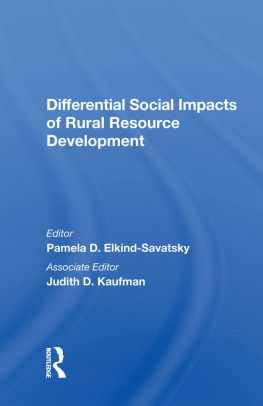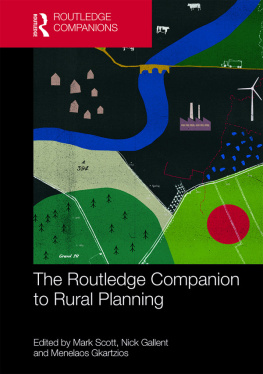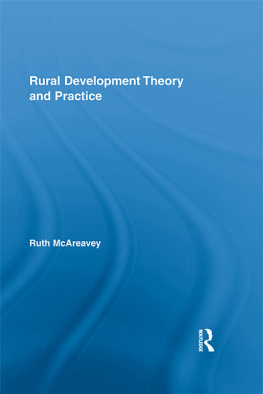About the Book and Editor
Assessing the social impact of rural development projects, the contributors to this book develop a cultural model based on theories of political economy and apply that model to a consideration of such factors as geography, language, economics, religion, and cultural patterns of domination. They focus on the interrelationship between cultural factors and social stratification. Their model serves as a means for moving from abstract discussions of political economy toward a practical application of social impact assessment.
The book begins with theoretical essays developing the conceptual model, followed by a review of the relevant social impact assessment literature and case studies of rural projects that have affected such socially disadvantaged groups as laborers, women, ranchers, and ethnic minorities. In the final two chapters, the authors apply and test the cultural model, using the findings of the case studies, and draw new conclusions about the differential effects of rural resource development projects.
Pamela D. Elkind-Savatsky is associate professor of sociology at Eastern Washington University.
Dedicated to Rhonda-T and Stacey Hara Savatsky
and to all the children of the contributors
Differential Social Impacts of Rural Resource Development
Social Impact Assessment Series C. P. Wolf, General Editor
What Happened to Fairbanks? The Effects of the Trans-Alaska Oil Pipeline on the Community of Fairbanks, Alaska , Mim Dixon
Social Impact Assessment and Monitoring: A Cross-Disciplinary Guide to the Literature , Michael J. Carley and Eduardo S. Bustelo
Integrated Impact Assessment , edited by Frederick A. Rossini and Alan L. Porter
Public Involvement and Social Impact Assessment , edited by Gregory A. Daneke, Margot W. Garcia, and Jerome Delli Priscoli
Applied Social Science for Environmental Planning , edited by William Millsap
Guide to Social Impact Assessment: A Framework for Assessing Social Change , Kristi Branch, Douglas A. Hooper, James Thompson, and James Creighton
Social Impact Analysis and Development Planning in the Third World , edited by William Derman and Scott Whiteford
Differential Social Impacts of Rural Resource Development , edited by Pamela D. Elkind-Savatsky
A Systems Approach to Social Impact Assessment: Two Alaskan Case Studies , Lawrence A. Palinkas, Bruce Murray Harris, and John S. Petterson
Differential Social Impacts of Rural Resource Development
Editor
Pamela D. Elkind-Savatsky
Associate Editor
Judith D. Kaufman
First published 1986 by Westview Press, Inc.
Published 2018 by Routledge
52 Vanderbilt Avenue, New York, NY 10017
2 Park Square, Milton Park, Abingdon, Oxon OX14 4RN
Routledge is an imprint of the Taylor & Francis Group, an informa business
Copyright 1986 Taylor & Francis
All rights reserved. No part of this book may be reprinted or reproduced or utilised in any form or by any electronic, mechanical, or other means, now known or hereafter invented, including photocopying and recording, or in any information storage or retrieval system, without permission in writing from the publishers.
Notice:
Product or corporate names may be trademarks or registered trademarks, and are used only for identification and explanation without intent to infringe.
Library of Congress Catalog Card Number: 86-51103
ISBN 13: 978-0-367-00631-0 (hbk)
Contents
, C. P. Wolf
Pamela D. Elkind-Savatsky
Jeffers W. Chertok
Richard P. Gale
Raymond L. Hall
William R. Freudenburg
Kristen R. Yount
Patrick C. Jobes
Elizabeth W. Moen
Ronald L. Little and Lynn A. Robbins
Simon J. Ortiz
Allan Schnaiberg
Raymond L. Hall
Pamela D. Elkind-Savatsky and Judith D. Kaufman
Jeffers W. Chertok........Eastern Washington University
Pamela D. Elkind-Savatsky.Eastern Washington University
William R. Freudenburg........University of Wisconsin, Madison
Richard . Gale.........University of Oregon
Raymond L. Hall.............Dartmouth College
Patrick C. Jobes............ Montana State University
Judith D. Kaufman............Eastern Washington University
Ronald L. Little............Utah State University
Elizabeth W. Moen.............University of Colorado
Simon J. Ortiz..............Pueblo of Acoma
Lynn A. Robbins.............Huxley College, Western Washington University
Allan Schnaiberg..............Northwestern University
Kristen R. Yount.........University of Kentucky
This book is about how different groups of people are differently affected by natural resource development in rural areas and in general. The groups considered are occupational (miners and ranchers), ethnic (Native Americans and Yupik Eskimos), age and gender (adolescents and women in western energy boomtowns). Their personal and social characteristics are bound up in a matrix of meanings and associations embodied and expressed in terms of culture and community. The consideration given them here varies among several intellectual and research traditions. One major axis of differentiation is that between the ethnographic (Little and Robbins, Freudenburg, Yount, Jobes, and Moen) and humanistic (Ortiz) on the one hand and that of political economy (Chertok, Gale, Schnaiberg) on the other. The degree of continuity and cohesion among these contributions is a tribute to the skill and persistence of authors and editors alike.
Traditional groups experiencing the impacts of rural resource development are often believed to suffer a common fate in the "destruction of community" (Erikson). The view advanced here rather emphasizes the distributiv e and differential impacts of rapid change. A dozen years ago I wrote that such impacts "... will be distributive in nature, the incidence of social benefits and detriments falling unevenly and unequally over various sectors and segments of the population, and... this will be more so the more highly differentiated the society becomes." This "dissociation" of social costs and benefits is a tenet and precept of social impact assessment (SIA). Indeed, the "bottom line" for SIA can be answered in terms of "Who are the winners and who are the losers?" Until now, this central interest of the field had not received focused study.
This central question is more than a little reminiscent of Harold Lasswell's classic definition of politics as the study of who gets what, where, when, and how. From the political economy perspective, the distribution of social benefits and burdens accords exactly with differential (and preferential) access to the means of production and administration and, we may add, communication and legitimation. The notion of "stratification" indicates differential access to and control over social goods of every description, notably power, possessions, and prestige. From the standpoint of cultural analysis, however, the intersection between culture and power is not simply a "political economy explanation for subcultural differentiation." This fundamental proposition is posed but not resolved in Hall's conceptual framework. Indeed, it is not yet evident what is the most suitable method of characterizing and describing cultural systems, though recent life course and social network analyses seem to hold considerable promise.





